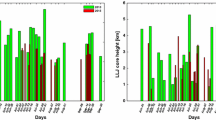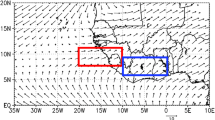Abstract
The Turkana low-level jet is a circulation feature over northern Kenya that is not spatially well-resolved in many observational datasets. Here, high-resolution TRMM, IMERG, and CMORPH precipitation estimates, along with the ERA5 and MERRA2 reanalyses are analyzed to better understand the controls on jet strength and the relationship between the jet and boreal summer rainfall variability in the jet exit region over South Sudan. The height of the South Sudan wet season, August, is analyzed for 2000–2017. Climatologically, rainfall peaks over the jet exit region during the early morning hours, coinciding with the jet maximum. The strong jet enhances low-level wind convergence and briefly shifts the low-level zonal moisture gradient westward. Over the western South Sudan, rainfall peaks in the late afternoon/evening in association with daytime heating. The correlation between the daily Turkana Jet strength and precipitation indicates a significant negative relationship over eastern South Sudan, and over the Ethiopian and East African Highlands. Composite analysis of strong and weak jet periods reveal that the atmospheric conditions associated with a strong jet include enhanced low-level ridging along the East African coast south of the equator resulting in a stronger height gradient in the Turkana Channel, as well drier conditions over the channel and adjacent highlands. These conditions support a stronger jet that is further enhanced by katabatic flow due to the stronger nighttime cooling over the highlands, as well as enhanced dry air advection over the jet exit region. Thus, while low-level convergence may increase, convection weakens over eastern South Sudan due to the reduced atmospheric moisture content and weaker instability. The opposite occurs for the weak jet case.















Similar content being viewed by others
References
Anderson DLT (1976) The low-level jet as a westerm boundary current. Mon Weather Rev 104:907–921. https://doi.org/10.1175/1520-0493(1976)104%3c0907:TLLJAA%3e2.0.CO;2
Bannon PR (1979) On the dynamics of the East African Jet. I: simulation of mean conditions for July. J Atmos Sci 36:2139–2152. https://doi.org/10.1175/1520-0469(1979)036%3c2139:OTDOTE%3e2.0.CO;2
Bunker AF (1965) Interaction of the summer monsoon air with the Arabian Sea. In: Proceedings of the symposium on meteorological results of t I.I.O.E., Bombay, 22–26 July 1965. Poona, Indian Meteorological Department, pp 3–16
Cook KH, Vizy EK (2012) Impact of climate change on mid-21st century growing seasons in Africa. Clim Dyn 39:2937–2955. https://doi.org/10.1007/s00382-012-1324-1
Cook KH, Vizy EK (2013) Projected changes in East African rainy seasons. J Clim 26:5931–5948. https://doi.org/10.1175/JCLI-D-12-00455.1
Crossett CC, Metz ND (2017) A climatological study of extreme cold surges along the African Highlands. J Appl Meteorol Climatol 56:1731–1738. https://doi.org/10.1175/JAMC-D-15-0191.1
Dee DP, Uppala SM, Simmons AJ et al (2011) The ERA-Interim reanalysis: configuration and performance of the data assimilation system. Q J R Meteorol Soc 137:553–597. https://doi.org/10.1002/qj.828
Dezfuli AK, Ichoku CM, Huffman GJ, Mohr KI, Selker JS, van de Giesen N, Hochreutener R, Annor FO (2017) Validation of IMERG precipitation in Africa. J Hydrometeorol 18:2817–2825. https://doi.org/10.1175/JHM-D-17-0139.1
ERA5 (2018) Generated using Copernicus Climate Change Service Information 2018. Neither The European Commission nor ECMWF is responsible for any use that may be made of the Copernicus Information of Data it contains. http://apps.ecmwf.int/data-catalogues/era5/?class=ea
Findlater J (1966) Cross-equatorial jet streams at low level over Kenya. Meteorol Mag 95:353–364
Findlater J (1969) A major low level air current near the Indian Ocean during the northern summer. Q J R Meteorol Soc 95:362–380. https://doi.org/10.1002/qj.49709540409
Findlater J (1977) Observational aspects of the low-level cross-equatorial jet stream of the western Indian Ocean. Pageoph 115:1251–1262. https://doi.org/10.1007/BF00874408
Funk C, Peterson P, Landsfeld M, Pedreros D, Verdin J, Shukla S, Husak G, Rowland J, Harrison L, Hoell A, Michaelsen J (2015) The climate hazards infrared precipitation with stations—a new environmental record for monitoring extremes. Sci Data 2:150066. https://doi.org/10.1038/sdata.2015.66
Gelaro R, McCarty W et al (2017) The modern-era retrospective analysis for research and applications, version 2 (MERRA-2). J Clim 30:5149–5454. https://doi.org/10.1175/JCLI-D-16-0758.1
Griffith JF (1972) Climate Survey of Africa, vol 10. World Survey of Climatology,m Elsevier, Amsterdam, p 604
Hart JE (1977) On the theory of the East African low level jet stream. Pageoph 115:1263–1282. https://doi.org/10.1007/BF00874409
Hart JE, Rao GV, Boogaard HVD, Young JA, Findlater J (1978) Arieal observations of the East African low-level jet stream. Mon Weather Rev 106:1714–1724. https://doi.org/10.1175/1520-0493(1978)106%3c1714:AOOTEA%3e2.0.CO;2
Hartman AT (2018) An analysis of the effects of temperatures and circulations on the strength of the low-level jet in the Turkana Channel in East Africa. Theor Appl Climatol 132:1003–1017. https://doi.org/10.1007/s00704-017-2121-x
Herrmann SM, Mohr KI (2011) A continental-scale classification of rainfall seasonality regimes in Africa based on gridded precipitation and land surface temperature products. J Appl Meteorol Climatol 50:2504–2513. https://doi.org/10.1175/JAMC-D-11-024.1
Huffman GJ, Adler RF, Bolvin DT, Gu G, Nelkin EJ, Bowman KP, Hong Y, Stocker EF, Wolff DB (2007) The TRMM multisatellite precipitation analysis (TMPA): quasi-global, multiyear, combined-sensor precipitation estimates at fine scales. J Hydrometeorol 8:38–55. https://doi.org/10.1175/JHM560.1
Huffman G, Bolvin D, Braithwaite, Hsu K, Joyce R, Xie P (2014) Integrated Multi-satellitE Retrievals for GPM (IMERG), version 4.4. NASA’s Precipitation Processing Center. ftp://arthurhou.pps.eosdis.nasa.gov/gpmdata. Accessed 1 June 2018
Indeje M, Semazzi FHM, Xie L (2001) Mechanistic model simulations of the East African climate using NCAR regional climate model: influence of large-scale orography on the Turkana low-level jet. J Climate 14:2710–2724. https://doi.org/10.1175/1520-0442(2001)014%3c2710:MMSOTE%3e2.0.CO;2
Joyce R, Janowiak J, Arkin PA, Xie P (2004) CMORPH: a method that produces global precipitation estimates from passive microwave and infrared data at high spatial and temporal resolution. J Hydrometeor 5:487–503. https://doi.org/10.1175/1525-7541(2004)005%3c0487:CAMTPG%3e2.0.CO;2
Kinuthia JH (1992) Horizontal and vertical structure of the Lake Turkana Jet. J Appl Meteorol 31:1248–1274. https://doi.org/10.1175/1520-0450(1992)031%3c1248:HAVSOT%3e2.0.CO;2
Kinuthia JH, Asnani GC (1982) A newly found jet in North Kenya (Turkana Channel). Mon Weather Rev 110:1722–1728. https://doi.org/10.1175/1520-0493(1982)110%3c1722:ANFJIN%3e2.0.CO;2
Kobayashi S, Ota Y, Harada Y, Ebita A, Moriya M, Onogi K, Kamahori H, Kobayashi C, Endo H, Miyaoka K, Takahashi K (2015) The JRA-55 reanalysis: general specifications and basic characteristics. J Meteorol Soc Jap 93:5–48. https://doi.org/10.2151/jmsj.2015-001
Krishnamurti TN, Molinari J, Pan H-L (1976) Numerical simulation of the Somali Jet. J Atmos Sci 33:2350–2362. https://doi.org/10.1175/1520-0469(1976)033%3c2350:NSOTSJ%3e2.0.CO;2
Levin NE, Zipser EJ, Cerling TE (2009) Isotopic composition of waters from Ethiopia and Kenya: insights into moisture sources for eastern Africa. J Geophys Res 114:D23306. https://doi.org/10.1029/2009JD012166
Liebmann B, Hoerling MP, Funk C, Bladé I, Dole RM, Allured D, Quan X, Pegion P, Eischeid JK (2014) Understanding recent eastern Horn of Africa rainfall variability and change. J Clim 27:8630–8645. https://doi.org/10.1175/JCLI-D-13-00714.1
Lu J (2018) ‘Unimaginable’ suffering in south Sudan. Is there any hope? In: NPR. https://www.npr.org/sections/goatsandsoda/2018/07/05/620184859/unimaginable-suffering-in-south-sudan-is-there-any-hope. Accessed 12 Dec 2018
Lyon B, DeWitt DG (2012) A recent and abrupt decline in the East African long rains. Geophys Res Lett 39:L02702. https://doi.org/10.1029/2011GL050337
Mekonnen A, Thorncroft CD (2016) On mechanisms that determine synoptic time scale convection over East Africa. Int J Climatol 36:4045–4057. https://doi.org/10.1002/joc.4614
Mekonnen A, Thorncroft CD, Aiyyer AR, Kiladis G (2008) Convectively coupled Kelvin waves over tropical Africa during the boreal summer: structure and variability. J Clim 21:6649–6667. https://doi.org/10.1175/2008JCLI2008.1
Metz ND, Archambault HM, Srock AF, Galarneau TJ Jr, Bosart LF (2013) A comparison of South American and African preferential pathways for extreme cold events. Mon Weather Rev 141:2066–2086. https://doi.org/10.1175/MWR-D-12-00202.1
Mukabana JR, Pielke RA (1996) Investigating the influence of synoptic-scale monsoonal winds and mesoscale circulations on diurnal weather patterns over Kenya using a mesoscale numerical model. Mon Weather Rev 124:224–242. https://doi.org/10.1175/1520-0493(1996)124%3c0224:ITIOSS%3e2.0.CO;2
Ngara T, Asnani GC (1978) Five-day oscillation in East African low-level jet. Nature 272:708–709. https://doi.org/10.1038/272708a0
Nicholson SE (1996) A review of climate dynamics and climate variability in eastern Africa. In: Johnson TC, Odada EO (eds) The limnology, climatology and paleoclimatology of the East African Lakes. Gordon and Breach, Toronto, pp 25–56
Nicholson SE (1998) Historical Fluctuations of Lake Victoria and Other Lakes in the Northern Rift Valley of East Africa. In: Lehman JT (eds) Environmental change and response in East African Lakes. Monographiae Biologicae, vol 79. Springer, Dordrecht. https://doi.org/10.1007/978-94-017-1437-2_2
Nicholson SE (2000) The nature of rainfall variability over Africa on times scales of decades to millennia. Glob Planet Change 26:137–158. https://doi.org/10.1016/S0921-8181(00)00040-0
Nicholson SE (2016) The Turkana low-level jet: mean climatology and association with regional aridity. Int J Climatol 36:2598–2614. https://doi.org/10.1002/joc.4515
ReliefWeb (2017) Republic of South Sudan: current and projected (January–July 2017) Acute Food Insecurity Situation—South Sudan. In: ReliefWeb https://reliefweb.int/report/south-sudan/republic-south-sudan-current-and-projeted-january-jul-2017-acute-food. Accessed 12 Dec 2018
Riddle EE, Cook KH (2008) Abrupt rainfall transitions over the Greater Horn of Africa: observations and regional model simulations. J Geophys Res 113:D15109. https://doi.org/10.1029/2007JD009202
Rodwell MJ, Hoskins BJ (1995) A model of the Asian summer monsoon. Part II: cross-equatorial flow and PV behavior. J Atmos Sci 52:1341–1356. https://doi.org/10.1175/1520-0469(1995)052%3c1341:AMOTAS%3e2.0.CO;2
Rowell DP, Booth BBB, Nicholson SE, Good P (2015) Reconciling past and future rainfall trends over East Africa. J Climate 28:9768–9788. https://doi.org/10.1175/JCLI-D-15-0140.1
Sun L, Semazzi FHM, Giorgi F, Ogallo L (1999) Application of the NCAR regional climate model to eastern Africa 1. Simulation of the short rains of 1988. J Geophys Res 104:6529–6548. https://doi.org/10.1029/1998JD200051
Trewartha GT (1981) The Earth’s problem climates. University of Wisconsin Press, Madison, p 340
Williams AP, Funk C, Michaelsen J, Rauscher SA, Robertson I, Wils THG, Koprowski M, Eshetu Z, Loader NJ (2012) Recent summer precipitation trends in the Greater Horn of Africa and the emerging role of Indian Ocean sea surface temperature. Clim Dyn 39:2307–2328. https://doi.org/10.1007/s00382-011-1222-y
Xie P, Joyce R, Wu S, Yoo S-H, Yarosh Y, Sun F, Lin R (2017) Reprocessed, biased-corrected CMORPH global high-resolution precipitation estimates from 1998. J Hydrometeorol 18:1617–1641. https://doi.org/10.1175/JHM-D-16-0168.1
Acknowledgements
This work was funded by NSF Award #1701520. The authors acknowledge the Texas Advanced Computing Center (TACC) at The University of Texas at Austin for providing HPC and database resources that have contributed to the research results reported within this paper. URL: http://www.tacc.utexas.edu. The Grid Analysis and Display System software (GrADS) developed at COLA/IGES was used for generating the figures. The authors would like to thank Declan Finney and the anonymous reviewer for their constructive comments and suggestions.
Author information
Authors and Affiliations
Corresponding author
Additional information
Publisher's Note
Springer Nature remains neutral with regard to jurisdictional claims in published maps and institutional affiliations.
Rights and permissions
About this article
Cite this article
Vizy, E.K., Cook, K.H. Observed relationship between the Turkana low-level jet and boreal summer convection. Clim Dyn 53, 4037–4058 (2019). https://doi.org/10.1007/s00382-019-04769-2
Received:
Accepted:
Published:
Issue Date:
DOI: https://doi.org/10.1007/s00382-019-04769-2




